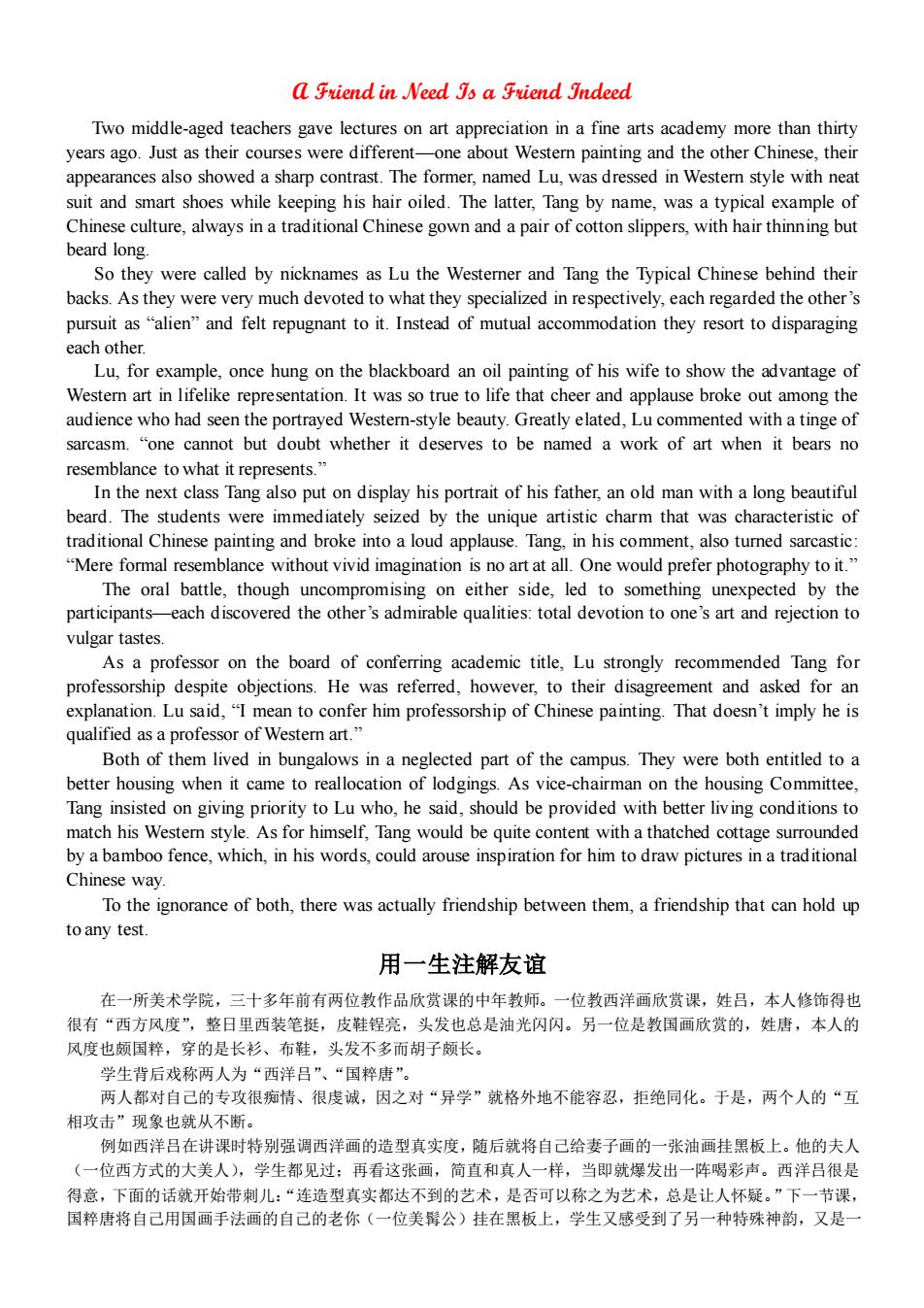正在加载图片...

a Friend in Need Is a Friend Indeed Two middle-aged teachers gave lectures on art appreciation in a fine arts academy more than thirty years ago.Just as their courses were different-one about Western painting and the other Chinese,their appearances also showed a sharp contrast.The former,named Lu,was dressed in Western style with neat suit and smart shoes while keeping his hair oiled.The latter,Tang by name,was a typical example of Chinese culture,always in a traditional Chinese gown and a pair of cotton slippers,with hair thinning but beard long. So they were called by nicknames as Lu the Westerner and Tang the Typical Chinese behind their backs.As they were very much devoted to what they specialized in respectively,each regarded the other's pursuit as "alien"and felt repugnant to it.Instead of mutual accommodation they resort to disparaging each other. Lu,for example,once hung on the blackboard an oil painting of his wife to show the advantage of Western art in lifelike representation.It was so true to life that cheer and applause broke out among the audience who had seen the portrayed Western-style beauty.Greatly elated,Lu commented with a tinge of sarcasm."one cannot but doubt whether it deserves to be named a work of art when it bears no resemblance to what it represents." In the next class Tang also put on display his portrait of his father,an old man with a long beautiful beard.The students were immediately seized by the unique artistic charm that was characteristic of traditional Chinese painting and broke into a loud applause.Tang,in his comment,also turned sarcastic: "Mere formal resemblance without vivid imagination is no art at all.One would prefer photography to it." The oral battle,though uncompromising on either side,led to something unexpected by the participants-each discovered the other's admirable qualities:total devotion to one's art and rejection to vulgar tastes. As a professor on the board of conferring academic title,Lu strongly recommended Tang for professorship despite objections.He was referred,however,to their disagreement and asked for an explanation.Lu said,"I mean to confer him professorship of Chinese painting.That doesn't imply he is qualified as a professor of Western art." Both of them lived in bungalows in a neglected part of the campus.They were both entitled to a better housing when it came to reallocation of lodgings.As vice-chairman on the housing Committee, Tang insisted on giving priority to Lu who,he said,should be provided with better living conditions to match his Western style.As for himself,Tang would be quite content with a thatched cottage surrounded by a bamboo fence,which,in his words,could arouse inspiration for him to draw pictures in a traditional Chinese way. To the ignorance of both,there was actually friendship between them,a friendship that can hold up to any test. 用一生注解友谊 在一所美术学院,三十多年前有两位教作品欣赏课的中年教师。一位教西洋画欣赏课,姓吕,本人修饰得也 很有“西方风度”,整日里西装笔挺,皮鞋锃亮,头发也总是油光闪闪。另一位是教国画欣赏的,姓唐,本人的 风度也颇国粹,穿的是长衫、布鞋,头发不多而胡子颇长。 学生背后戏称两人为“西洋吕”、“国粹唐”。 两人都对自己的专攻很痴情、很虔诚,因之对“异学”就格外地不能容忍,拒绝同化。于是,两个人的“互 相攻击”现象也就从不断。 例如西洋吕在讲课时特别强调西洋画的造型真实度,随后就将自己给妻子画的一张油画挂黑板上。他的夫人 (一位西方式的大美人),学生都见过:再看这张画,简直和真人一样,当即就爆发出一阵喝彩声。西洋吕很是 得意,下面的话就开始带刺儿:“连造型真实都达不到的艺术,是否可以称之为艺术,总是让人怀疑。”下一节课, 国粹唐将自己用国画手法画的自己的老你(一位美髯公)挂在黑板上,学生又感受到了另一种特殊神韵,又是一A Friend in Need Is a Friend Indeed Two middle-aged teachers gave lectures on art appreciation in a fine arts academy more than thirty years ago. Just as their courses were different—one about Western painting and the other Chinese, their appearances also showed a sharp contrast. The former, named Lu, was dressed in Western style with neat suit and smart shoes while keeping his hair oiled. The latter, Tang by name, was a typical example of Chinese culture, always in a traditional Chinese gown and a pair of cotton slippers, with hair thinning but beard long. So they were called by nicknames as Lu the Westerner and Tang the Typical Chinese behind their backs. As they were very much devoted to what they specialized in respectively, each regarded the other’s pursuit as “alien” and felt repugnant to it. Instead of mutual accommodation they resort to disparaging each other. Lu, for example, once hung on the blackboard an oil painting of his wife to show the advantage of Western art in lifelike representation. It was so true to life that cheer and applause broke out among the audience who had seen the portrayed Western-style beauty. Greatly elated, Lu commented with a tinge of sarcasm. “one cannot but doubt whether it deserves to be named a work of art when it bears no resemblance to what it represents.” In the next class Tang also put on display his portrait of his father, an old man with a long beautiful beard. The students were immediately seized by the unique artistic charm that was characteristic of traditional Chinese painting and broke into a loud applause. Tang, in his comment, also turned sarcastic: “Mere formal resemblance without vivid imagination is no art at all. One would prefer photography to it.” The oral battle, though uncompromising on either side, led to something unexpected by the participants—each discovered the other’s admirable qualities: total devotion to one’s art and rejection to vulgar tastes. As a professor on the board of conferring academic title, Lu strongly recommended Tang for professorship despite objections. He was referred, however, to their disagreement and asked for an explanation. Lu said, “I mean to confer him professorship of Chinese painting. That doesn’t imply he is qualified as a professor of Western art.” Both of them lived in bungalows in a neglected part of the campus. They were both entitled to a better housing when it came to reallocation of lodgings. As vice-chairman on the housing Committee, Tang insisted on giving priority to Lu who, he said, should be provided with better living conditions to match his Western style. As for himself, Tang would be quite content with a thatched cottage surrounded by a bamboo fence, which, in his words, could arouse inspiration for him to draw pictures in a traditional Chinese way. To the ignorance of both, there was actually friendship between them, a friendship that can hold up to any test. 用一生注解友谊 在一所美术学院,三十多年前有两位教作品欣赏课的中年教师。一位教西洋画欣赏课,姓吕,本人修饰得也 很有“西方风度”,整日里西装笔挺,皮鞋锃亮,头发也总是油光闪闪。另一位是教国画欣赏的,姓唐,本人的 风度也颇国粹,穿的是长衫、布鞋,头发不多而胡子颇长。 学生背后戏称两人为“西洋吕”、“国粹唐”。 两人都对自己的专攻很痴情、很虔诚,因之对“异学”就格外地不能容忍,拒绝同化。于是,两个人的“互 相攻击”现象也就从不断。 例如西洋吕在讲课时特别强调西洋画的造型真实度,随后就将自己给妻子画的一张油画挂黑板上。他的夫人 (一位西方式的大美人),学生都见过;再看这张画,简直和真人一样,当即就爆发出一阵喝彩声。西洋吕很是 得意,下面的话就开始带刺儿:“连造型真实都达不到的艺术,是否可以称之为艺术,总是让人怀疑。”下一节课, 国粹唐将自己用国画手法画的自己的老你(一位美髯公)挂在黑板上,学生又感受到了另一种特殊神韵,又是一